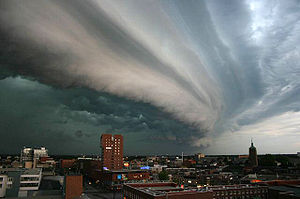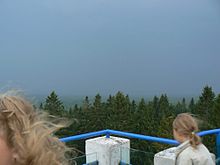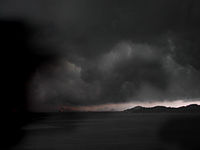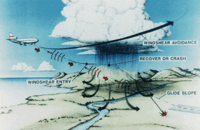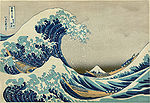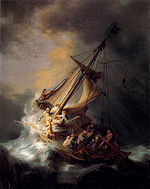- Storm
-
"Windstorm" redirects here. For the type of storm in Europe, see European windstorm. For the Gloria Jones album, see Windstorm (album).For other uses, see Storm (disambiguation).
A storm (from Proto-Germanic *sturmaz "noise, tumult") is any disturbed state of an astronomical body's atmosphere, especially affecting its surface, and strongly implying severe weather. It may be marked by strong wind, hail, thunder and/or lightning (a thunderstorm), heavy precipitation (snowstorm, rainstorm), heavy freezing rain (ice storm), strong winds (tropical storm, hurricane, windstorm) or wind transporting some substance through the atmosphere (as in a dust storm, blizzard, sandstorm, etc.). Storms generally lead to negative impacts to lives and property, such as storm surge, heavy rain or snow (causing flooding or road impassibility), lightning, wildfires, and vertical wind shear; however, systems with significant rainfall can alleviate drought in places they move through. Heavy snowfall can allow special recreational activities to take place which would not be possible otherwise, such as skiing and snowmobiling.
Contents
Formation
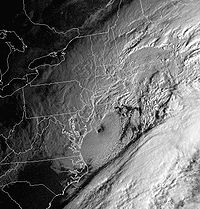 Satellite image of the intense nor'easter responsible for the North American blizzard of 2006. Note the hurricane-like eye at the center.
Satellite image of the intense nor'easter responsible for the North American blizzard of 2006. Note the hurricane-like eye at the center.
Storms are created when a center of low pressure develops, with a system of high pressure surrounding it. This combination of opposing forces can create winds and result in the formation of storm clouds, such as the cumulonimbus. Small, localized areas of low pressure can form from hot air rising off hot ground, resulting in smaller disturbances such as dust devils and whirlwinds.
Types
3-second video of a lightning strike within a thunderstorm over Island in the Sky, Canyonlands National Park
There are many varieties and names for storms.
- Ice Storm - Ice storms are one of the most dangerous forms of winter storms. When surface temperatures are below freezing, but a thick layer of above freezing air remains aloft above ground level, rain can fall into the freezing layer and freeze upon impact into a "glaze", which is known as freezing rain. In general, 8 millimetres (0.31 in) of accumulation is all that is required, especially in combination with breezy conditions, to start downing power lines as well as tree limbs.[1] Ice storms also make unheated road surfaces too slick to drive upon. Ice storms can vary in time range from hours to days and can cripple both small towns and large urban centers alike.
- Blizzard - There are varying definitions for blizzards, both over time and by location. In general, a blizzard is accompanied by gale-force winds, heavy snow (accumulating at a rate of at least 5 centimeters (2 in) per hour), and very cold conditions (below approximately -10 degrees Celsius or 14 F). As of late, the temperature criterion has fallen out of the definition across the United States[2]
- Snowstorm - A heavy fall of snow accumulating at a rate of more than 5 centimeters (2 in) per hour that lasts several hours. Snow storms, especially ones with a high liquid equivalent and breezy conditions, can down tree limbs, cut off power, and paralyze travel over a large region.
- Ocean Storm - Storm conditions out at sea are defined as having sustained winds of 48 knots (55 mph or 90 km/h) or greater.[3] Usually just referred to as a storm, these systems can sink vessels of all types and sizes.
- Firestorm - Firestorms are conflagrations which attain such intensity that they create and sustain their own wind systems. It is most commonly a natural phenomenon, created during some of the largest bushfires, forest fires, and wildfires. The Peshtigo Fire is one example of a firestorm. Firestorms can also be deliberate effects of targeted explosives such as occurred as a result of the aerial bombings of Dresden and Tokyo during World War II. Nuclear detonations almost invariably generate firestorms
- Dust devil - a small, localized updraft of rising air.
- Wind storm - A storm marked by high wind with little or no precipitation.[4] Windstorm damage often opens the door for massive amounts of water and debris to cause further damage to a structure.[5] European windstorms and derechos are two type of windstorms.[6]
- Squall - sudden onset of wind increase of at least 16 knots (30 km/h) or greater sustained for at least one minute.
- Gale - An extratropical storm with sustained winds between 34-48 knots (39-55 mph or 63–90 km/h).[3]
- Thunderstorm - A thunderstorm is a type of storm that generates lightning and the attendant thunder. It is normally accompanied by heavy precipitation. Thunderstorms occur throughout the world, with the highest frequency in tropical rainforest regions where there are conditions of high humidity and temperature along with atmospheric instability. These storms occur when high levels of condensation form in a volume of unstable air that generates deep, rapid, upward motion in the atmosphere. The heat energy creates powerful rising air currents that swirl upwards to the tropopause. Cool descending air currents produce strong downdraughts below the storm. After the storm has spent its energy, the rising currents die away and downdraughts break up the cloud. Individual storm clouds can measure 2–10 km across.
- Tropical Cyclone - A tropical cyclone is a storm system with a closed circulation around a centre of low pressure, fueled by the heat released when moist air rises and condenses. The name underscores its origin in the tropics and their cyclonic nature. Tropical cyclones are distinguished from other cyclonic storms such as nor'easters and polar lows by the heat mechanism that fuels them, which makes them "warm core" storm systems.
- Tropical cyclones form in the oceans if the conditions in the area are favorable, and depending on their strength and location, there are various terms by which they are called, such as tropical depression, tropical storm, hurricane and typhoon.[7]
- Hailstorm - a type of storm that precipitates chunks of ice. Hailstorms usually occur during regular thunder storms. While most of the hail that precipitates from the clouds is fairly small and virtually harmless, there have been cases of hail greater than 2 inches diameter that caused much damage and injuries.
- Tornado - A tornado is a violent, destructive wind storm occurring on land. Usually its appearance is that of a dark, funnel-shaped cyclone. Often tornadoes are preceded by a thunderstorm and a wall cloud. They are often called the most destructive of storms, and while they form all over the world, the interior of the United States is the most prone area, especially throughout Tornado Alley.
Classification
A strict meteorological definition of a terrestrial storm is a wind measuring 10 or higher on the Beaufort scale, meaning a wind speed of 24.5 m/s (89 km/h, 55 mph) or more; however, popular usage is not so restrictive. Storms can last anywhere from 12 to 200 hours, depending on season and geography. The east and northeast storms are noted for the most frequent repeatability and duration, especially during the cold period.[8] Big terrestrial storms alter the oceanographic conditions that in turn may affect food abundance and distribution: strong currents, strong tides, increased siltation, change in water temperatures, overturn in the water column, etc.
Extraterrestrial storms
Storms are not unique to Earth; other planetary bodies with a sufficient atmosphere (gas giants in particular) also undergo stormy weather. A famous example is the Great Red Spot on Jupiter. Though technically an anticyclone with greater than hurricane wind speeds, it is larger than the earth and has been raging for at least 340 years, having first been observed by astronomer Galileo Galilei. Neptune also had its own lesser known Great Dark Spot.
In September 1994 Hubble telescope using Wide Field Planetary Camera 2 imaged the storms on Saturn, generated by upwelling of warmer air, similar to a terrestrial thunderhead. The east-west extent of the same-year storm was equal to the diameter of Earth. The storm was observed earlier in September 1990 and acquired the name Dragon Storm.
The dust storms of Mars are variable in size, but can often cover the entire planet. They tend to occur when Mars is closest to the Sun, and have been shown to increase the global temperature.[9]
Two known extrasolar planets have known to be possess storms: HD 209458 b[10] and HD 80606 b. The former's storm was discovered on June 23, 2010 and measured at 6,200 km/h, while the latter has shockwave storms whipping around the planet in 12 hours.
Effects on human society
See also: Acid rain, Effects of tropical cyclones, Hail, Lightning, Snow, Wildfire, Wind, and Wind shear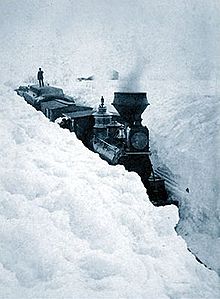 A snow blockade in southern Minnesota, US in 1881
A snow blockade in southern Minnesota, US in 1881
Shipwrecks are common with the passage of strong tropical cyclones. Such shipwrecks can change the course of history,[11] as well as influence art and literature. A hurricane led to a victory of the Spanish over the French for control of Fort Caroline, and ultimately the Atlantic coast of North America, in 1565.[12] Strong winds from any storm type can damage or destroy vehicles, buildings, bridges, and other outside objects, turning loose debris into deadly flying projectiles. In the United States, major hurricanes comprise just 21% of all landfalling tropical cyclones, but account for 83% of all damage.[13] Tropical cyclones often knock out power to tens or hundreds of thousands of people, preventing vital communication and hampering rescue efforts.[14] Tropical cyclones often destroy key bridges, overpasses, and roads, complicating efforts to transport food, clean water, and medicine to the areas that need it. Furthermore, the damage caused by tropical cyclones to buildings and dwellings can result in economic damage to a region, and to a diaspora of the population of the region.[15] The storm surge, or the increase in sea level due to the cyclone, is typically the worst effect from landfalling tropical cyclones, historically resulting in 90% of tropical cyclone deaths.[15] The relatively quick surge in sea level can move miles/kilometers inland, flooding homes and cutting off escape routes. The storm surges and winds of hurricanes may be destructive to human-made structures, but they also stir up the waters of coastal estuaries, which are typically important fish breeding locales.
Cloud-to-ground lightning frequently occur within the phenomena of thunderstorms and have numerous hazards towards landscapes and populations. One of the more significant hazards lightning can pose is the wildfires they are capable of igniting.[16] Under a regime of low precipitation (LP) thunderstorms, where little precipitation is present, rainfall cannot prevent fires from starting when vegetation is dry as lightning produces a concentrated amount of extreme heat.[17] Wildfires can devastate vegetation and the biodiversity of an ecosystem. Wildfires that occur close to urban environments can inflict damages upon infrastructures, buildings, crops, and provide risks to explosions, should the flames be exposed to gas pipes. Direct damage caused by lightning strikes occurs on occasion.[18] In areas with a high frequency for cloud-to-ground lightning, like Florida, lightning causes several fatalities per year, most commonly to people working outside.[19]
Precipitation with low potential of hydrogen levels (pH), otherwise known as acid rain, is also a frequent risk produced by lightning. Distilled water, which contains no carbon dioxide, has a neutral pH of 7. Liquids with a pH less than 7 are acidic, and those with a pH greater than 7 are bases. “Clean” or unpolluted rain has a slightly acidic pH of about 5.2, because carbon dioxide and water in the air react together to form carbonic acid, a weak acid (pH 5.6 in distilled water), but unpolluted rain also contains other chemicals.[20] Nitric oxide present during thunderstorm phenomena,[21] caused by the splitting of nitrogen molecules, can result in the production of acid rain, if nitric oxide forms compounds with the water molecules in precipitation, thus creating acid rain. Acid rain can damage infrastructures containing calcite or other solid chemical compounds containing carbon. In ecosystems, acid rain can dissolve plant tissues of vegetations and increase acidification process in bodies of water and in soil, resulting in deaths of marine and terrestrial organisms.[22]
Hail damage to roofs often goes unnoticed until further structural damage is seen, such as leaks or cracks. It is hardest to recognize hail damage on shingled roofs and flat roofs, but all roofs have their own hail damage detection problems.[5] Metal roofs are fairly resistant to hail damage, but may accumulate cosmetic damage in the form of dents and damaged coatings.[23] Hail is also a common nuisance to drivers of automobiles, severely denting the vehicle and cracking or even shattering windshields and windows. Rarely, massive hailstones have been known to cause concussions or fatal head trauma. Hailstorms have been the cause of costly and deadly events throughout history. One of the earliest recorded incidents occurred around the 9th century in Roopkund, Uttarakhand, India.[24] The largest hailstone in terms of diameter and weight ever recorded in the United States fell on July 23, 2010 in Vivian, South Dakota in the United States; it measured 8 inches (20 cm) in diameter and 18.62 inches (47.3 cm) in circumference, weighing in at 1.93 pounds (0.88 kg).[25] This broke the previous record for diameter set by a hailstone 7 inches diameter and 18.75 inches circumference which fell in Aurora, Nebraska in the United States on June 22, 2003, as well as the record for weight, set by a hailstone of 1.67 pounds (0.76 kg) that fell in Coffeyville, Kansas in 1970.[25]
Various hazards, ranging from hail to lightning can have an impact on outside technology facilities, such as antennas, satellite dishes, and towers. As a result, companies with outside facilities have begun installing such facilities underground, in order to reduce the risk of damage from storms.[26]
Substantial snowfall can disrupt public infrastructure and services, slowing human activity even in regions that are accustomed to such weather. Air and ground transport may be greatly inhibited or shut down entirely. Populations living in snow-prone areas have developed various ways to travel across the snow, such as skis, snowshoes, and sleds pulled by horses, dogs, or other animals and later, snowmobiles. Basic utilities such as electricity, telephone lines, and gas supply can also fail. In addition, snow can make roads much harder to travel and vehicles attempting to use them can easily become stuck.[27]
The combined effects can lead to a "snow day" on which gatherings such as school, work, or church are officially canceled. In areas that normally have very little or no snow, a snow day may occur when there is only light accumulation or even the threat of snowfall, since those areas are unprepared to handle any amount of snow. In some areas, such as some states in the United States, schools are given a yearly quota of snow days (or "calamity days"). Once the quota is exceeded, the snow days must be made up.[28][29][30] In other states, all snow days must be made up.[31] For example, schools may extend the remaining school days later into the afternoon, shorten spring break, or delay the start of summer vacation.
Accumulated snow is removed to make travel easier and safer, and to decrease the long-term impact of a heavy snowfall. This process utilizes shovels and snowplows, and is often assisted by sprinkling salt or other chloride-based chemicals, which reduce the melting temperature of snow.[32] In some areas with abundant snowfall, such as Yamagata Prefecture, Japan, people harvest snow and store it surrounded by insulation in ice houses. This allows the snow to be used through the summer for refrigeration and air conditioning, which requires far less electricity than traditional cooling methods.[33]
Agriculture
Hail can cause serious damage, notably to automobiles, aircraft, skylights, glass-roofed structures, livestock, and most commonly, farmers' crops.[34] Wheat, corn, soybeans, and tobacco are the most sensitive crops to hail damage.[35] Hail is one of Canada's most expensive hazards.[36] Snowfall can be beneficial to agriculture by serving as a thermal insulator, conserving the heat of the Earth and protecting crops from subfreezing weather. Some agricultural areas depend on an accumulation of snow during winter that will melt gradually in spring, providing water for crop growth. If it melts into water and refreezes upon sensitive crops, such as oranges, the resulting ice will protect the fruit from exposure to lower temperatures.[37] Although tropical cyclones take an enormous toll in lives and personal property, they may be important factors in the precipitation regimes of places they affect and bring much-needed precipitation to otherwise dry regions. Hurricanes in the eastern north Pacific often supply moisture to the Southwestern United States and parts of Mexico.[38] Japan receives over half of its rainfall from typhoons.[39] Hurricane Camille averted drought conditions and ended water deficits along much of its path,[40] though it also killed 259 people and caused $9.14 billion (2005 USD) in damage.
Aviation
Hail is one of the most significant thunderstorm hazards to aircraft.[41] When hail stones exceed 0.5 inches (13 mm) in diameter, planes can be seriously damaged within seconds.[42] The hailstones accumulating on the ground can also be hazardous to landing aircraft. Strong wind outflow from thunderstorms causes rapid changes in the three-dimensional wind velocity just above ground level. Initially, this outflow causes a headwind that increases airspeed, which normally causes a pilot to reduce engine power if they are unaware of the wind shear. As the aircraft passes into the region of the downdraft, the localized headwind diminishes, reducing the aircraft's airspeed and increasing its sink rate. Then, when the aircraft passes through the other side of the downdraft, the headwind becomes a tailwind, reducing lift generated by the wings, and leaving the aircraft in a low-power, low-speed descent. This can lead to an accident if the aircraft is too low to effect a recovery before ground contact. As the result of the accidents in the 1970s and 1980s, in 1988 the U.S. Federal Aviation Administration mandated that all commercial aircraft have on-board wind shear detection systems by 1993. Between 1964 and 1985, wind shear directly caused or contributed to 26 major civil transport aircraft accidents in the U.S. that led to 620 deaths and 200 injuries. Since 1995, the number of major civil aircraft accidents caused by wind shear has dropped to approximately one every ten years, due to the mandated on-board detection as well as the addition of Doppler weather radar units on the ground. (NEXRAD)[43]
Recreation
 Making a giant snowball
Making a giant snowball
Many winter sports, such as skiing,[44] snowboarding,[45] snowmobiling,[46] and snowshoeing depend upon snow. Where snow is scarce but the temperature is low enough, snow cannons may be used to produce an adequate amount for such sports.[47] Children and adults can play on a sled or ride in a sleigh. Although a person's footsteps remain a visible lifeline within a snow-covered landscape, snow cover is considered a general danger to hiking since the snow obscures landmarks and makes the landscape itself appear uniform.[48]
One of the recognizable recreational uses of snow is in building snowmen. A snowman is created by making a man shaped figure out of snow – often using a large, shaped snowball for the body and a smaller snowball for the head which is often decorated with simple household items – traditionally including a carrot for a nose, and coal for eyes, nose and mouth; occasionally including old clothes such as a top hat or scarf.
Snow can be used to make snow cones, also known as snowballs, which are usually eaten in the summer months.[49] Flat areas of snow can be used to make snow angels, a popular pastime for children.
Snow can be used to alter the format of outdoor games such as Capture the flag,[50] or for snowball fights. The world's biggest snowcastle, the SnowCastle of Kemi, is built in Kemi, Finland every winter.[51] Since 1928 Michigan Technological University in Houghton, Michigan has held an annual Winter Carnival in mid-February, during which a large Snow Sculpture Contest takes place between various clubs, fraternities, and organizations in the community and the university. Each year there is a central theme, and prizes are awarded based on creativity.[52] Snowball softball tournaments are held in snowy areas, usually using a bright orange softball for visibility, and burlap sacks filled with snow for the bases.[53]
Notable storms in art and culture
According to the Bible, a giant storm sent by God flooded the Earth. Noah and his family and the animals entered the Ark, and "the same day were all the fountains of the great deep broken up, and the windows of heaven were opened, and the rain was upon the earth forty days and forty nights." The flood covered even the highest mountains to a depth of more than twenty feet, and all creatures died; only Noah and those with him on the Ark were left alive. In the New Testament, Jesus Christ is recorded to have calmed a storm on the Sea of Galilee.
In Greek mythology there were several gods of storms: Briareos, the god of sea storms; Aigaios, a god of the violent sea storms; and Aiolos, keeper of storm-winds, squalls and tempests.
The Sea Venture was wrecked near Bermuda in 1609 which led to the colonization of Bermuda[54] and provided the inspiration for Shakespeare's The Tempest. William Shakespeare's play The Tempest (1611) was based on the following incident.[55] Sir Thomas Gates, future governor of Virginia, was on his way to England from Jamestown, Virginia. On Saint James Day while between Cuba and the Bahamas a hurricane raged for nearly two days. Though one of the small vessels in the fleet sank to the bottom of the Florida Straits, seven of the remaining vessels reached Virginia within several days after the storm. The flagship of the fleet, known as Sea Adventure, disappeared and was presumed lost. A small bit of fortune befell the ship and her crew when they made landfall on Bermuda. The vessel was damaged on a surrounding coral reef, but all aboard survived for nearly a year on the island. The British colonists claimed the island and quickly settled Bermuda. In May 1610, they set forth for Jamestown, this time arriving at their destination.
The Romantic seascape painters J. M. W. Turner and Ivan Aivazovsky created some of the most lasting impressions of the sublime and stormy seas that are firmly imprinted on the popular mind. Turner's representations of powerful natural forces reinvented the traditional seascape during the first half of the nineteenth century. Upon his travels to Holland, he took note of the familiar large rolling waves of the English seashore transforming into the sharper, choppy waves of a Dutch storm. A characteristic example of Turner’s dramatic seascape is The Slave Ship of 1840. Aivazovsky left several thousand turbulent canvases in which he increasingly eliminated human figures and historical background to focus on such essential elements as light, sea, and sky. His grandiose Ninth Wave (1850) is an ode to human daring in the face of the elements.
Storms were also portrayed in several works of music. Examples are Beethoven's Pastoral Symphony (the fourth movement), Presto of the violin concerto RV 315 (Summer) from the Four Seasons by Vivaldi, and a scene in Act II of Rossini's opera The Barber of Seville.
See also
Part of the Nature series on
WeatherCalendar seasons Spring · Summer
Tropical seasonsStorms Thunderstorm · Supercell
Downburst · Lightning
Tornado · Waterspout
Tropical cyclone (Hurricane)
Extratropical cyclone
Winter storm · Blizzard · Ice storm
Dust storm · Firestorm · CloudPrecipitation Drizzle · Rain · Snow · Graupel
Freezing rain · Ice pellets · HailTopics Meteorology · Climate
Weather forecasting
Heat wave · Air pollutionWeather portal - Anticyclonic storm
- Dust storm
- Heat storm
- Perfect storm
- Pulse storm
- Salt storm
- Splitting storm
- Super storm
- Nor'easter
- Storm cellar
- Storm door
- Storm drain
- Storm room
- Storm windows
- Atmospheric pressure
- Convective storm detection
- Extreme weather, a list of historical storms and other extreme weather
- Geomagnetic storm
- Ice storm warning
- Local storm report
- National Oceanic and Atmospheric Administration
- Storm cell
- Storm chasing
- Storm glass
- Storm moon
- Storm spotter
- Storm warning
- Storm-scale
- Winter storm warning
- Winter storm watch
References
- ^ City of Kent, Washington. Snow/Ice Storm. Retrieved on 2006-11-26.
- ^ University Corporation for Atmospheric Research. Winter Storms. Retrieved on 2006-11-26.
- ^ a b Ocean Prediction Center. Terminology and Weather Symbols. Retrieved on 2006-11-26.
- ^ "windstorm|Retrieved on 2009-10-26.". merriam-webster. http://www.merriam-webster.com/dictionary/windstorm.
- ^ a b "Hurricane and windstorm coverage". Adjusters International. http://www.adjustersinternational.com/AdjustingToday/ATfullinfo.cfm?start=2&page_no=2&pdfID=1. Retrieved 2007.
- ^ "Derecho|Retrieved on 2010-07-17.". National Oceanic and Atmospheric Administration. http://www.spc.noaa.gov/misc/AbtDerechos/derechofacts#definition.
- ^ Atlantic Oceanographic and Meteorological Laboratory. Frequently Asked Questions Subject: A1) What is a hurricane, typhoon, or tropical cyclone? Retrieved on 2006-11-26.
- ^ Тецйн Чефтб
- ^ Philips, Tony (July 16, 2001). "Planet Gobbling Dust Storms". Science @ NASA. http://science.nasa.gov/headlines/y2001/ast16jul_1.htm. Retrieved 2006-06-07.
- ^ Rincon, Paul (23 June 2010). "'Superstorm' rages on exoplanet". BBC News London. http://news.bbc.co.uk/2/hi/science_and_environment/10393633.stm. Retrieved 2010-06-24.
- ^ Edward N. Rappaport and Jose Fernandez-Partagas. The Deadliest Atlantic Tropical Cyclones, 1492-1996. Retrieved on 2008-01-01.
- ^ Sun-Sentinel. Hurricane timeline: 1495 to 1800. Retrieved on 2007-10-03.
- ^ Chris Landsea (1998). "How does the damage that hurricanes cause increase as a function of wind speed?". Hurricane Research Division. http://www.aoml.noaa.gov/hrd/tcfaq/D5.html. Retrieved 2007-02-24.
- ^ Staff Writer (2005-08-30). "Hurricane Katrina Situation Report #11". Office of Electricity Delivery and Energy Reliability (OE) United States Department of Energy. http://www.oe.netl.doe.gov/docs/katrina/katrina_083005_1600.pdf. Retrieved 2007-02-24.
- ^ a b James M. Shultz, Jill Russell and Zelde Espinel (2005). "Epidemiology of Tropical Cyclones: The Dynamics of Disaster, Disease, and Development". Oxford Journal. http://epirev.oxfordjournals.org/cgi/content/full/27/1/21. Retrieved 2007-02-24.
- ^ Scott, A (2000). "The Pre-Quaternary history of fire". Palaeogeography Palaeoclimatology Palaeoecology 164: 281. doi:10.1016/S0031-0182(00)00192-9.
- ^ Vladimir A. Rakov (1999). "Lightning Makes Glass". University of Florida, Gainesville. http://plaza.ufl.edu/rakov/Gas.html. Retrieved November 7, 2007.
- ^ Bruce Getz and Kelli Bowermeister (2009-01-09). "Lightning and Its Hazards". Hughston Sports Medicine Foundation. http://www.hughston.com/hha/a_12_3_4.htm. Retrieved 2009-09-09.
- ^ Charles H. Paxton, J. Colson and N. Carlisle (2008). "P2.13 Florida lightning deaths and injuries 2004–2007". American Meteorological Society. http://ams.confex.com/ams/88Annual/techprogram/paper_132808.htm. Retrieved 2009-09-05.
- ^ G. E. Likens, W. C. Keene, J. M. Miller and J. N. Galloway (1987). "Chemistry of precipitation from a remote, terrestrial site in Australia". Journal of Geophysical Research 92 (13): 299–314. Bibcode 1987JGR....92..299R. doi:10.1029/JA092iA01p00299.
- ^ Joel S. Levine, Tommy R. Augustsson, Iris C. Andersont, James M. Hoell Jr., and Dana A. Brewer (1984). "Tropospheric sources of NOx: Lightning and biology". Atmospheric Environment 18 (9): 1797–1804. doi:10.1016/0004-6981(84)90355-X. PMID 11540827. http://www.sciencedirect.com/science?_ob=ArticleURL&_udi=B757C-488FRK0-2N&_user=10&_rdoc=1&_fmt=&_orig=search&_sort=d&_docanchor=&view=c&_searchStrId=1001036955&_rerunOrigin=google&_acct=C000050221&_version=1&_urlVersion=0&_userid=10&md5=05e7b4ab4444bada8188d84c8a19ccc0. Retrieved 2009-09-04.
- ^ Office of Air and Radiation Clean Air Markets Division (2008-12-01). "Effects of Acid Rain – Surface Waters and own Aquatic Animals". United States Environmental Protection Agency. http://www.epa.gov/acidrain/effects/surface_water.html. Retrieved 2009-09-05.
- ^ "Metal Roofing". http://www.infinityroofer.com/metal-roofing.
- ^ David Orr (2004-11-07). "Giant hail killed more than 200 in Himalayas". Telegraph Group Unlimited via the Internet Wayback Machine. Archived from the original on 2005-12-03. http://web.archive.org/web/20051203015218/http://www.telegraph.co.uk/news/main.jhtml?xml=/news/2004/11/07/wind07.xml&sSheet=/news/2004/11/07/ixworld.html. Retrieved 2009-08-28.
- ^ a b "Hailstone record press release". National Weather Service. 2010-07-30. http://www.crh.noaa.gov/crh/pdf/073010RecordHailVivianSD.pdf.
- ^ Newman, Robert C. (2009). Computer Security: Protecting Digital Resources. Sudbury, MA: Jones & Bartlett Learning. pp. 100. ISBN 0763759945. http://books.google.com/?id=_R5ndK-i3vkC&pg=PA100&dq=%22storm+damage%22#v=onepage&q=%22storm%20damage%22&f=false.
- ^ Laura Cheshire (1997). "Have Snow Shovel, Will Travel". National Snow and Ice Data Center. http://nsidc.org/snow/shovel.html. Retrieved 2009-07-08.
- ^ Dave Larsen (2009-01-27). "School districts are using up calamity days". Dayton Daily News (Dayton, Ohio: Cox Enterprises). http://www.daytondailynews.com/n/content/oh/story/news/local/2009/01/27/ddn012709calamityweb.html. Retrieved 2009-02-05. "Ohio school districts can use five calamity days before they must start adding extra days to the school calendar."
- ^ Donna Willis (2009-01-30). "Districts Consider Calamity Options". WCMH-TV (Columbus, Ohio: Media General). http://www.nbc4i.com/cmh/news/local/education/article/districts_consider_calamity_options/12343/. Retrieved 2009-02-05.
- ^ Joleen Ferris (2009-01-28). "Decision for city schools to stay open prompts calls from irate parents". WKTV (Utica, New York: Smith Media). http://www.wktv.com/news/local/38543532.html. Retrieved 2009-02-05.
- ^ Christine Wolff, Tanya Albert (1999-03-09). "Snow may stretch out school year". The Cincinnati Enquirer (Cincinnati, Ohio: Gannett Company). http://www.enquirer.com/editions/1999/03/10/loc_snow_may_stretch_out.html. Retrieved 2009-02-05.
- ^ David A. Kuemmel (1994). Managing roadway snow and ice control operations. Transportation Research Board. p. 10. ISBN 9780309056663. http://books.google.com/?id=I3gxuwTE5_MC&pg=PA10. Retrieved 2009-07-08.
- ^ United Nations Environment Programme (Winter 1996). "Using Snow For Cool, Innovative Solutions". Insight. http://www.unep.or.jp/ietc/Publications/INSIGHT/Win-96/9.asp. Retrieved 2009-07-08.
- ^ Nolan J. Doesken (April 1994). "Hail, Hail, Hail ! The Summertime Hazard of Eastern Colorado". Colorado Climate 17 (7). http://www.cocorahs.org/media/docs/hail_1994.pdf. Retrieved 2009-07-18.
- ^ John E. Oliver (2005). Encyclopedia of World Climatology. Springer. p. 401. ISBN 9781402032646. http://books.google.com/?id=-mwbAsxpRr0C&pg=PA401&lpg=PA401&dq=hail+regions+with+most+deaths&q=hail%20regions%20with%20most%20deaths. Retrieved 2009-08-28.
- ^ Damon P. Coppola (2007). Introduction to international disaster management. Butterworth-Heinemann. p. 62. ISBN 9780750679824. http://books.google.com/?id=s6oxEraqWWwC&pg=RA1-Pa61&lpg=RA1-PA61&dq=causes+of+accumulating+hail+storms&q=hail.
- ^ M. Baldwin (2002-09-08). "How Cold Can Water Get?". Argonne National Laboratory. http://www.newton.dep.anl.gov/askasci/gen01/gen01243.htm. Retrieved 2009-04-16.
- ^ National Oceanic and Atmospheric Administration 2005 Tropical Eastern North Pacific Hurricane Outlook accessed May 2, 2006
- ^ Whipple, Addison (1982). Storm. Alexandria, VA: Time Life Books. pp. 54. ISBN 0-8094-4312-0.
- ^ Christopherson, Robert W. (1992). Geosystems: An Introduction to Physical Geography. New York: Macmillan Publishing Company. pp. 222–224. ISBN 0-02-322443-6.
- ^ P.R. Field, W.H. Hand, G. Cappelluti et al. (November 2010). "Hail Threat Standardisation". European Aviation Safety Agency. RP EASA.2008/5. http://www.easa.europa.eu/safety-and-research/research-projects/docs/large-aeroplanes/EASA.2008_5.pdf.
- ^ Federal Aviation Administration (2009). "Hazards". http://www.aviationweather.ws/063_Hazards.php. Retrieved 2009-08-29.
- ^ National Aeronautics and Space Administration, Langley Air Force Base (June 1992). "Making the Skies Safer From Windshear". http://oea.larc.nasa.gov/PAIS/Windshear.html. Retrieved 2006-10-22.
- ^ Christopher Clarey (1998-02-01). "NAGANO '98; Building a Better Snowman Through Science". New York Times. http://www.nytimes.com/1998/02/01/sports/nagano-98-building-a-better-snowman-through-science.html?pagewanted=1. Retrieved 2009-07-08.
- ^ Sam Baldwin (January 2006). "Skiers vs Snowboaders: The Dying Feud". SnowSphere.com. http://www.snowsphere.com/special-features/snowboarding-vs-skiing-the-dying-feud. Retrieved 2009-07-08.
- ^ "Snowmobiling Facts". International Snowmobile Manufacturers Associations. 2006. http://www.snowmobile.org/facts_snfcts.asp. Retrieved 2007-04-23.
- ^ Jeffrey Selingo (2001-02-08). "Machines Let Resorts Please Skiers When Nature Won't". New York Times. http://query.nytimes.com/gst/fullpage.html?res=9900EEDA1631F93BA35751C0A9679C8B63&sec=&spon=&pagewanted=all. Retrieved 2009-07-08.
- ^ Washington Trails Association (2007-12-05). "Winter Hiking and Avalanche Danger". http://www.wta.org/trail-news/news/winter-hiking-and-avalanche-danger. Retrieved 2009-07-10.
- ^ Michelle Geinow (1996-09-18). "Cold Comfort: On the Cultural Significance of the Snowball in Baltimore". The City Paper. http://www.citypaper.com/bob/story.asp?id=8153. Retrieved 2009-07-10.
- ^ Mary Mapes Dodge (1907). St. Nicholas. University of Michigan. p. 241. ISBN 0217849938. http://books.google.com/?id=_KNNAAAAMAAJ&pg=PA241&lpg=PA241. Retrieved 2009-07-10.
- ^ Adam Forrest (January 6, 2008). "SNOW sundayherald briefing". The Sunday Herald. http://findarticles.com/p/articles/mi_qn4156/is_20080106/ai_n21186637/. Retrieved 2009-07-07.
- ^ Michigan Technological University (2009-05-27). "A Frigid Place Gets a Blast From Space". http://www.mtu.edu/carnival/. Retrieved 2009-07-10.
- ^ Jason Gabak (2008-02-23). "Snow softball a slippery sport". The Citizen. http://www.auburnpub.com/articles/2008/02/24/local_news/news04.txt. Retrieved 2009-07-10.
- ^ Peter Linebaugh and Marcus Rediker. The Wreck of the Sea-Venture.
- ^ David M. Roth. Seventeenth Century Virginia Hurricanes. Retrieved on 2006-11-26.
Sister project links
 Media related to Storm at Wikimedia Commons
Media related to Storm at Wikimedia Commons  The Wiktionary definition of storm
The Wiktionary definition of storm  Quotations related to Storm at Wikiquote
Quotations related to Storm at Wikiquote Chisholm, Hugh, ed (1911). "storm". Encyclopædia Britannica (11th ed.). Cambridge University Press.
Chisholm, Hugh, ed (1911). "storm". Encyclopædia Britannica (11th ed.). Cambridge University Press.
Categories:- Weather hazards
- Storm
Wikimedia Foundation. 2010.

